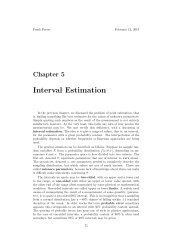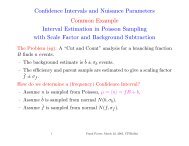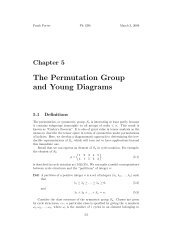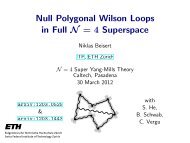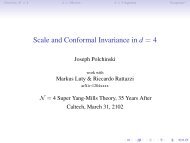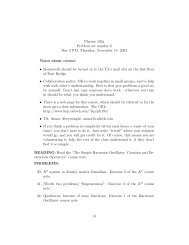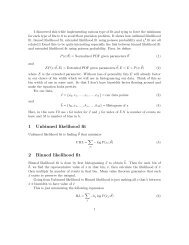1 Introduction 2 Resolvents and Green's Functions
1 Introduction 2 Resolvents and Green's Functions
1 Introduction 2 Resolvents and Green's Functions
Create successful ePaper yourself
Turn your PDF publications into a flip-book with our unique Google optimized e-Paper software.
<strong>and</strong><br />
|k〉 = φ k (x), (15)<br />
we define<br />
G(x, y; z) = ∑ φ k (x)φ ∗ k(y)<br />
, (16)<br />
k<br />
q k − z<br />
so that G operates on a wave function according to<br />
∫<br />
[G(z)ψ] (x) = d 3 (y)G(x, y; z)ψ(y). (17)<br />
(∞)<br />
Thus G(x, y; z) is the kernel of an integral transform. We may see that this<br />
correspondence is as claimed as follows: Exp<strong>and</strong><br />
ψ(y) = ∑ l<br />
ψ l φ l (y). (18)<br />
Then<br />
∫<br />
d 3 (y) ∑ φ k (x)φ ∗ k(y) ∑<br />
ψ l φ l (y)<br />
(∞)<br />
k<br />
q k − z<br />
l<br />
= ∑ φ k (x) ∑<br />
∫<br />
ψ l d 3 (y)φ ∗<br />
k<br />
q k − z<br />
k(y)φ l (y)<br />
l<br />
(∞)<br />
= ∑ ψ k φ k (x)<br />
k<br />
q k − z . (19)<br />
This is to be compared with<br />
[G(z)ψ] (x) = ∑ k<br />
= ∑ k<br />
1<br />
q k − z |k〉〈k| ∑ ψ l |l〉<br />
l<br />
ψ k φ k (x)<br />
q k − z . (20)<br />
We have thus demonstrated the representation as an integral transform. Similar<br />
results would apply on other L 2 spaces of wave functions besides L 2 (R 3 ).<br />
Consider now the formal relation:<br />
1<br />
(Q − z)G(z) = (Q − z) = I. (21)<br />
Q − z<br />
Corresponding to this, we have operator: 2<br />
(Q x − z)G(x, y; z) = δ (3) (x − y), (22)<br />
2 We use a subscript x on Q to denote that, if, for example, Q is a differential operator,<br />
the differentiation is on variable x.<br />
3




